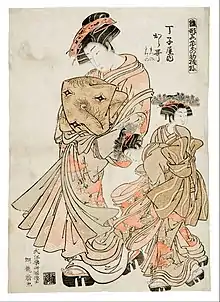Koryūsai
Isoda Koryūsai (礒田 湖龍斎, 1735–1790) was a Japanese ukiyo-e print designer and painter active from 1769 to 1790.

Life and career
Koryūsai was born in 1735 and worked as a samurai in the service of the Tsuchiya clan. He became a masterless rōnin after the death of the head of the clan and moved to Edo (modern Tokyo) where he settled near Ryōgoku Bridge in the Yagenbori area. He became a print designer there under the art name Haruhiro in 1769, at first making samurai-themed designs. The ukiyo-e print master Harunobu died in 1770, and about that time Koryūsai began making prints in a similar style of life in the pleasure districts.[1]
Koryūsai was a prolific designer of individual prints and print series,[1] most of which appeared between 1769 and 1881.[2]
In 1782 Koryūsai applied for and received the Buddhist honour hokkyō ("Bridge of the Law")[1] from the imperial court[3] and thereafter used the title as part of his signature. His output slowed from this time, though he continued to design prints until his death in 1790.[1]
Work
Koryūsai's known designs total 2500, or an average of four a week. According to art historian Allen Hockley, "Koryūsai may ... have been the most productive artist of the eighteenth century".[2]
The series Models for Fashion: New Designs as Fresh Young Leaves (Hinagata wakana no hatsumoyō, 1776–81) ran for 140 prints, the longest ukiyo-e print series of beauties known. He designed at least 350 hashira-e pillar prints, numerous kachō-e bird-and-flower prints, a great number of shunga erotic prints, and others.[1] 90 of his nikuhitsu-ga paintings are known, making him one of the most productive painters of the period.[2]

Legacy
Despite the Koryūsai's productivity and popularity—both in his time and amongst later collectors—his work has attracted little scholarship.[4] The first ukiyo-e histories written in the West in the 19th century elevated certain artists as examplars; Koryūsai work came to be seen as too indebted to Harunobu, who died in 1770, and inferior to Kiyonaga, whose peak period came in the 1880s.[3] An example is Woldemar von Seidlitz's Geschichte des japanischen Farbenholzschnittes ("History of Japanese colour prints", 1897), the most popular of the early ukiyo-e histories, which paints Koryūsai as a successor to Harunobu and a rival of Kiyonaga's in the 1770s who slipped into mediocrity and imitation of his rival by the end of the decade.[5] Interest lay mainly in the details of Koryūsai's life—a samurai who received court honours was unusual in the proletarian world of ukiyo-e.[3] In 2021, contemporary woodblock printmaker David Bull created a series of 12 prints depicting nature scenes adapted from Koryūsai's designs.[6][7]
His work is held in the permanent collections of several museums worldwide, including the British Museum,[8] the Museum of Fine Arts, Boston,[9] the Carnegie Museum of Art,[10] the Princeton University Art Museum,[11] the Minneapolis Institute of Art,[12] the University of Michigan Museum of Art,[13] the Hermitage Museum,[14] the Suntory Museum of Art,[15] the Israel Museum,[16] the Krannert Art Museum,[17] the Los Angeles County Museum of Art,[18] the Philadelphia Museum of Art,[19] the Honolulu Museum of Art,[20] the Museum of New Zealand,[21] the Brooklyn Museum,[22] the Ashmolean Museum,[23] the Fine Arts Museum of San Francisco,[24] the Freer Gallery of Art,[25] the Indianapolis Museum of Art,[26] the Chazen Museum of Art,[27] the Portland Art Museum,[28] and the Kimbell Art Museum.[29]
References
- Marks 2012, p. 60.
- Hockley 2003, p. 3.
- Hockley 2003, p. 4.
- Hockley 2003, pp. 3–4.
- Hockley 2003, p. 11.
- David, Bull (13 December 2020). "Mokuhankan Japanese Prints - 2020 Update". YouTube.
- "Scenes from Nature". mokuhankan.com. Retrieved 2021-01-15.
- "kakemono-e | British Museum". The British Museum. Retrieved 2021-02-05.
- "Matsunoi and Matsui of the Matsubaya". collections.mfa.org. Retrieved 2021-02-05.
- "CMOA Collection". collection.cmoa.org. Retrieved 2021-02-05.
- "Twelve Aspects of Children (Fūryū kodomo jūnishi 風流子供十二支) (1996-207)". artmuseum.princeton.edu. Retrieved 2021-02-05.
- "Red, Isoda Koryūsai ^ Minneapolis Institute of Art". collections.artsmia.org. Retrieved 2021-02-05.
- "Exchange: A Tea-house Girl from the Iseya". exchange.umma.umich.edu. Retrieved 2021-02-05.
- "Tea Ceremony - Isoda Koryusai". www.arthermitage.org. Retrieved 2021-02-05.
- "Search Results: Search Conditions [Isoda Koryusai]: Collection Database". SUNTORY MUSEUM of ART. Retrieved 2021-02-05.
- "Isoda Koryusai, Japan, active ca. 1764-88 | The Israel Museum, Jerusalem". www.imj.org.il. Retrieved 2021-02-05.
- "Isoda Koryusai, A Standing Courtesan, 1775. Work on paper. Gift of the Class of 1908 1974-15-1 | Krannert Art Museum". kam.illinois.edu. Retrieved 2021-02-05.
- "Isoda Koryūsai | LACMA Collections". collections.lacma.org. Retrieved 2021-02-05.
- "Philadelphia Museum of Art - Collections Object : Minazuki The Sixth Month (Three Women and a Baby)". www.philamuseum.org. Retrieved 2021-02-05.
- "Michinoku with Attendants, Isoda Koryūsai (1735-1790) | Allure". Retrieved 2021-02-05.
- "Loading... | Collections Online - Museum of New Zealand Te Papa Tongarewa". collections.tepapa.govt.nz. Retrieved 2021-02-05.
- "Brooklyn Museum". www.brooklynmuseum.org. Retrieved 2021-02-05.
- "Ashmolean". collections.ashmolean.org. Retrieved 2021-02-05.
- "Night Rain, from the series Eight Elegant Views of Nagauta Performances - Isoda Koryūsai". FAMSF Search the Collections. 2015-05-08. Retrieved 2021-02-05.
- "Beauties of the Seasons---Winter". Freer Gallery of Art & Arthur M. Sackler Gallery. Retrieved 2021-02-05.
- "Mandarin Ducks". Indianapolis Museum of Art Online Collection. Retrieved 2021-02-05.
- "Three Cranes, Pines, and Rising Sun | 8549". Chazen Museum of Art. Retrieved 2021-02-05.
- "Isoda Koryūsai". portlandartmuseum.us. Retrieved 2021-02-05.
- "Courtesan Playing the Samisen | Kimbell Art Museum". www.kimbellart.org. Retrieved 2021-02-05.
Works cited
- Hockley, Allen (2003). The Prints of Isoda Koryūsai: Floating World Culture and Its Consumers in Eighteenth-century Japan. University of Washington Press. ISBN 978-0-295-98301-1.CS1 maint: ref=harv (link)
- Marks, Andreas (2012). Japanese Woodblock Prints: Artists, Publishers and Masterworks: 1680–1900. Tuttle Publishing. ISBN 978-1-4629-0599-7.CS1 maint: ref=harv (link)
External links
 Media related to Isoda Koryusai at Wikimedia Commons
Media related to Isoda Koryusai at Wikimedia Commons- Works
- Artelino